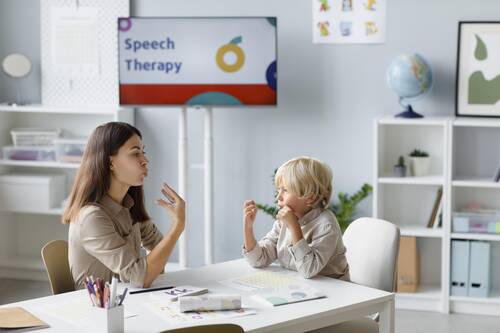Brain injuries have the ability to dramatically and permanently alter the life of a person. And among the range of effects brain injury has, the most commonly observed consequence is speech disorders.
The improvement in understanding these disorders has also led to significant advancement in speech therapy. Speech-language pathologists now have a range of techniques and therapeutic protocols at their disposal. The rate of success for speech therapy has also made great strides with many patients now making full recoveries.
Technology has been benefitting the field of speech therapy for ages, but living in the digital age; we have not seen such a jump in innovations that have been helping speech-language pathologists (SLPs), otherwise known as speech therapists, better diagnose and treat patients as we have in the past few years, both in and out of therapy.
In this article, we’ll discuss the cutting-edge technology, from tools to apps, that has been implemented to improve the role of speech therapy.
What are the limitations and challenges faced by speech pathologists?
As with all professions, speech therapists also share a number of limitations and challenges when it providing effective treatment for individuals. While they do make a huge difference in the lives of their patients, here are some of the biggest hurdles that SLPs face in their field:- Sessions and treatment are time-consuming - speech therapy requires multiple in-person sessions on a weekly basis in order to see results. It’s because of this that many people don’t attend sessions as they don’t have the time or resources to make it to regular sessions.
- It can be difficult to keep individuals engaged - many of the methods used in traditional speech therapy can seem tedious and less engaging. This makes it difficult to motivate individuals to perform, especially when working with young children.
- Limited accessibility - another huge limitation of speech therapy is that it’s not readily available in underserved and rural areas, which means there are a lot of people not receiving treatment purely because there isn’t a speech therapist close by.
 If you're an adult, having a lisp can be more than a problem. It can affect everything from your relationships to your interactions and job opportunities. Things like feeling self-conscious when talking about facing difficulties in professions can impact your confidence over time. But is it possible to fix a lisp after childhood? Luckily, it can often be fixed, and whether you're suffering from this condition or studying for the speech pathologist online degree, this article will take you through the reasons behind lisps in adults, how effective speech therapy is and even self-help methods.
(more…)
If you're an adult, having a lisp can be more than a problem. It can affect everything from your relationships to your interactions and job opportunities. Things like feeling self-conscious when talking about facing difficulties in professions can impact your confidence over time. But is it possible to fix a lisp after childhood? Luckily, it can often be fixed, and whether you're suffering from this condition or studying for the speech pathologist online degree, this article will take you through the reasons behind lisps in adults, how effective speech therapy is and even self-help methods.
(more…)
Tongue twisters are not just for fun; they are powerful tools for enhancing speech clarity and confidence. Whether you're a kid or an adult, learning and practicing tongue twisters can significantly improve pronunciation skills and articulation. They make speech improvement an enjoyable and engaging activity that encourages frequent practice without feeling like a chore.
 Each tongue twister challenges your mouth and tongue to move in complex ways that can help hone your pronunciation skills. This repetitive exercise can increase your ability to articulate tricky sounds, making everyday conversations clearer and more confident. Moreover, using these fun phrases can provide a light-hearted approach to learning, which can be especially beneficial in easy speech therapy activities for both children and adults.
By incorporating a variety of easy and entertaining tongue twisters into your daily routine, you create a playful yet productive environment for speech practice. This not only makes the process more enjoyable but also encourages consistent practice, which is essential for noticeable improvement. Ready to put your tongue to the test? Dive into our carefully selected list of 10 easy and fun tongue twisters designed specifically for speech improvement. Please note that this is an informational article and not a substitute for medical advice. If you need further assistance, consult a medical professional.
Each tongue twister challenges your mouth and tongue to move in complex ways that can help hone your pronunciation skills. This repetitive exercise can increase your ability to articulate tricky sounds, making everyday conversations clearer and more confident. Moreover, using these fun phrases can provide a light-hearted approach to learning, which can be especially beneficial in easy speech therapy activities for both children and adults.
By incorporating a variety of easy and entertaining tongue twisters into your daily routine, you create a playful yet productive environment for speech practice. This not only makes the process more enjoyable but also encourages consistent practice, which is essential for noticeable improvement. Ready to put your tongue to the test? Dive into our carefully selected list of 10 easy and fun tongue twisters designed specifically for speech improvement. Please note that this is an informational article and not a substitute for medical advice. If you need further assistance, consult a medical professional.
 Each tongue twister challenges your mouth and tongue to move in complex ways that can help hone your pronunciation skills. This repetitive exercise can increase your ability to articulate tricky sounds, making everyday conversations clearer and more confident. Moreover, using these fun phrases can provide a light-hearted approach to learning, which can be especially beneficial in easy speech therapy activities for both children and adults.
By incorporating a variety of easy and entertaining tongue twisters into your daily routine, you create a playful yet productive environment for speech practice. This not only makes the process more enjoyable but also encourages consistent practice, which is essential for noticeable improvement. Ready to put your tongue to the test? Dive into our carefully selected list of 10 easy and fun tongue twisters designed specifically for speech improvement. Please note that this is an informational article and not a substitute for medical advice. If you need further assistance, consult a medical professional.
Each tongue twister challenges your mouth and tongue to move in complex ways that can help hone your pronunciation skills. This repetitive exercise can increase your ability to articulate tricky sounds, making everyday conversations clearer and more confident. Moreover, using these fun phrases can provide a light-hearted approach to learning, which can be especially beneficial in easy speech therapy activities for both children and adults.
By incorporating a variety of easy and entertaining tongue twisters into your daily routine, you create a playful yet productive environment for speech practice. This not only makes the process more enjoyable but also encourages consistent practice, which is essential for noticeable improvement. Ready to put your tongue to the test? Dive into our carefully selected list of 10 easy and fun tongue twisters designed specifically for speech improvement. Please note that this is an informational article and not a substitute for medical advice. If you need further assistance, consult a medical professional.
Key Takeaways
- Tongue twisters are effective for improving speech clarity.
- Regular practice boosts pronunciation skills and confidence.
- They offer a fun and engaging way to enhance speech therapy activities.


